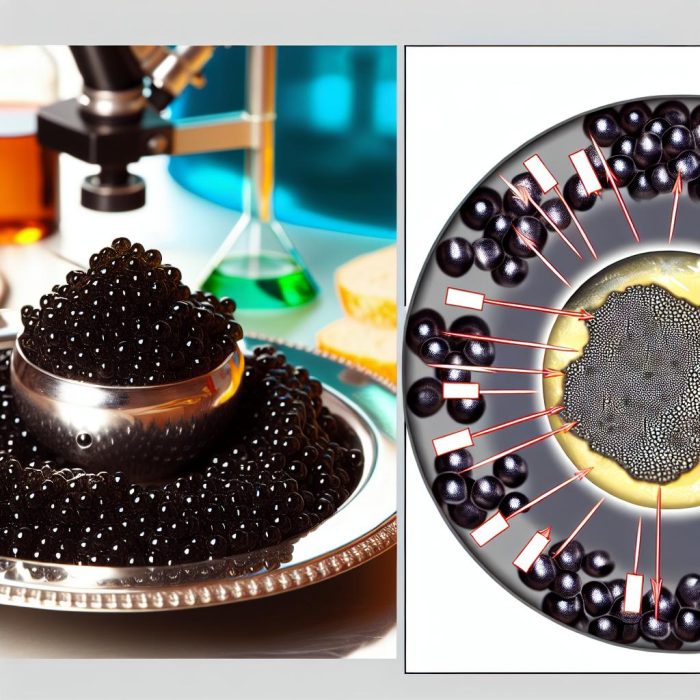The Unique Texture of Caviar
Caviar is renowned for its distinctive texture, a characteristic that distinguishes it as a luxury delicacy. Beluga, Osetra, and Sevruga sturgeon, the primary sources of traditional caviar, contribute to the variety in texture through different egg sizes and firmness. At the microscopic level, the texture of caviar is determined by its composition of proteins, lipids, and water. These components form a delicate outer membrane that encases the roe, allowing it to burst with slight pressure, an experience often described as a “pop” on the palate.
The maturity of the fish eggs significantly influences texture. Younger sturgeon eggs tend to be softer, while mature eggs are firmer and more defined in texture. Furthermore, the curing process, which involves salting the roe, plays a critical role. Properly controlled salting ensures preservation while maintaining the optimal firmness of the eggs.
Culinary Influence: Salt and Oil Content
Salt and oil content contribute to both the flavor and texture of caviar. Salt is used as a preservative and flavor enhancer, balancing the natural taste of the roe. Different regions and producers adopt diverse salting techniques impacting the final product’s texture. Malossol, meaning ‘little salt’, is a popular method offering a less saline and more delicate taste.
The oil content, inherent in fish roe, provides the characteristic smoothness of caviar. The balance between the roe’s oiliness and protein structure affects the perceived richness and creamy texture.
Impact of Egg Maturity on Texture
The maturity of the eggs when harvested plays a crucial role in determining the texture of caviar. Younger eggs, which come from less mature sturgeons, exhibit a softer texture, slightly more pliable on the palate. They are often perceived as more delicate in flavor and texture, offering a subtlety that some connoisseurs prefer. On the other hand, fully mature eggs are undeniably firmer, showcasing a more robust texture that some regard as unmistakable of premium caviar. This level of firmness allows for a more pronounced “pop”, enhancing the sensory pleasure derived from tasting caviar.
Regional Variations in Caviar Texture
The global spread of caviar production has led to significant regional variations in texture due to differing methods of rearing and processing. While some regions may emphasize minimal intervention to let the natural qualities of the roe shine, others might adopt techniques that enhance specific textural attributes. The Russian and Iranian methods have traditionally set the standards for classical texture preferences. However, emerging producers are experimenting with novel techniques that may emphasize less traditional textures, offering a broader spectrum of culinary experiences with caviar.
Global Trends and Consumer Preferences
In a world where food trends are continually evolving, consumer preferences for caviar texture and flavor continue to diversify. While the traditional texture of caviar remains popular, there’s an increasing appreciation for variations that include softer, more buttery profiles as opposed to just the classic firm texture. These trends are influenced by changing palates and the global availability of different sturgeon types, making it possible for consumers to explore a wider variety of caviar textures.
Influence of Storage on Texture
Proper storage is essential in maintaining caviar’s texture. Caviar should be kept at temperatures between -2 to 2 degrees Celsius to avoid spoilage and maintain its integrity. At optimal temperatures, the roe retains its firmness and flavor. Mismanagement in storage conditions can lead to unpleasantly mushy or overly firm textures.
Temperature control is paramount in preserving the textural quality of caviar over time. Without the proper conditions, the outer membrane of the roe could either become too robust, diminishing the sought-after pop, or deteriorate into mushiness, losing its distinct texture entirely. Moreover, prolonged exposure to higher temperatures can cause oils within the roe to oxidize, impacting both texture and flavor negatively.
Textural Variations Through Processing
Processing also plays an essential role in defining the texture of caviar. Beyond simple salt curing, there are processes like pressing which can alter the caviar’s composition, resulting in different texture profiles. Fine-tuning these procedures allows producers to cater to various personal preferences and regional tastes.
Flavor Profile of Caviar
The flavor profile of caviar is as complex as its texture. Influenced by myriad factors, the flavor ranges from delicate and buttery to rich and briny. The sturgeon species significantly dictates these inherent flavors. Marine diet and habitat likewise influence the roe’s flavor nuances.
The careful balance of environmental factors and precise processing determines the desirable taste attributes in caviar. Producers often adjust these variables in minor yet significant ways to develop caviar that meets specific market demands.
Environmental and Processing Impact on Flavor
Environmental factors, such as water quality and sturgeon diet, shape the unique taste of caviar. High-quality, pristine water bodies are essential for producing the most refined caviar. Moreover, processing and curing impact the final flavor, where minimal handling and meticulous salting ensure that the natural flavors dominate.
Flavor balance remains a critical element in the enjoyment of caviar. As taste preferences diversify globally, producers continue to innovate, discovering how distinct environmental niches and processing techniques might yield new and exciting flavors, broadening the scope of this luxury delicacy in new consumer markets.
In conclusion, understanding the science behind caviar’s texture and flavor enhances appreciation for this luxurious delicacy—highlighting the importance of species selection, environmental conditions, and precise processing techniques. By appreciating the texture and flavor interconnections and how they are influenced by various factors, consumers can develop a more profound respect for the craft and complexity behind each serving, maintaining caviar’s place as a time-honored luxury food item.

